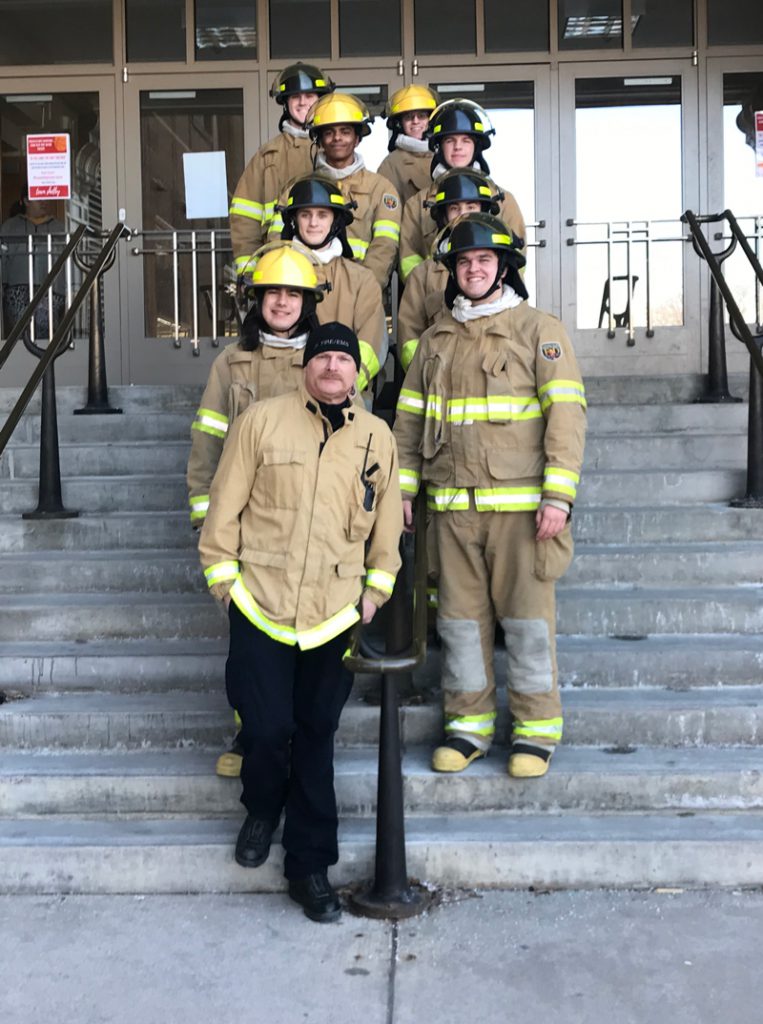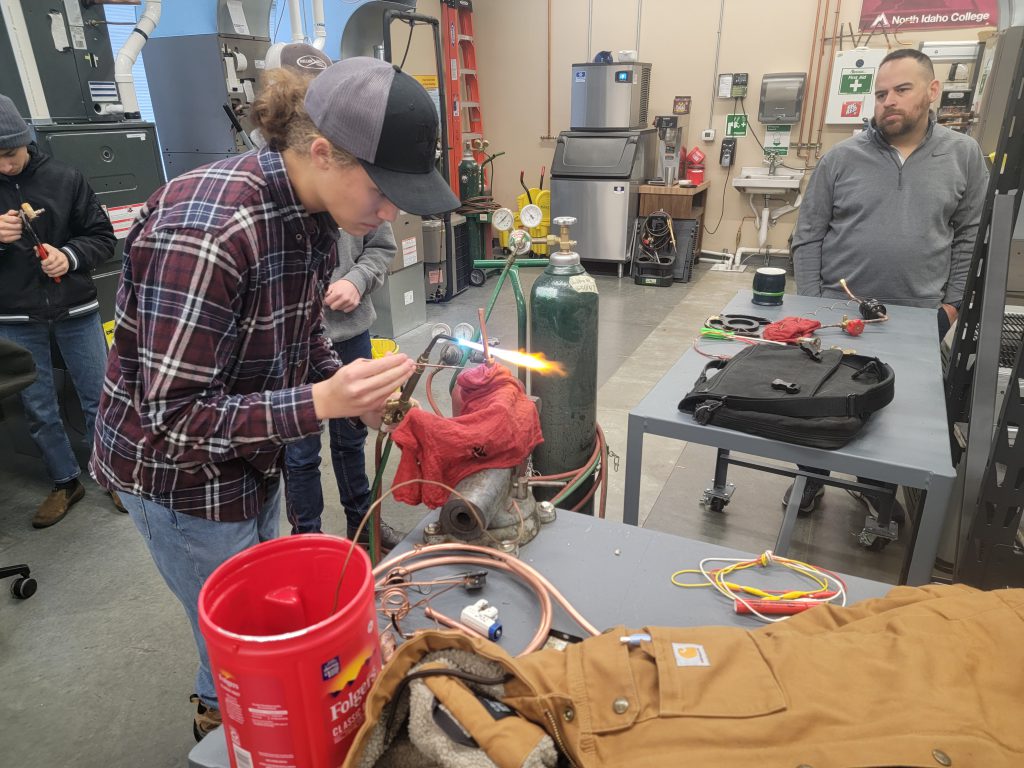Tag: Secondary
High school fire program helps fill workforce need in the Portneuf Valley


When veteran firefighter Mark Brood agreed to do a presentation on volunteer firefighting at Pocatello High School in 2015, he had no idea where it would lead.
“Right after my presentation, I got hauled down to the principal’s office,” said Brood. “Lisa (Delonas) told me they had a first responder academy, but they didn’t have an EMT or a fire component. She asked if I would be interested in helping get it up and running. I guess it was a case of being in the right place at the right time.”
In his 29 years in the fire service, Brood had trained a lot of new firefighters, so he was up for the challenge. As an active fire chief with the North Bannock Fire Department, he could also rely on his industry connections to establish the program. Fortunately, Brood received much support from Superintendent Dr. Douglas Howell, the school board, the school district, and the fire community. Throughout Eastern Idaho, donations poured in, including turnouts (the protective gear worn by firefighters) from the city of Chubbuck, various equipment from the city of Pocatello, and fire hoses from the Idaho Falls Fire Department.
One of the reasons the community rallied around the program is the growing need for first responders and the fact that so many small communities in Idaho rely on the service of volunteer firefighters.
“In these communities, shopkeepers, farmers, ranchers, and neighbors just drop whatever they’re doing when the bell rings and hop on the fire truck as it goes by,” said Rhonda Naftz, career technical education administrator for School District No. 25. “It’s like training them to fulfill their civic duty. This CTE program can bring this service to smaller communities.”
The Pocatello/Chubbuck School District renovated a building to house the career technical school program and purchased a retired fire engine using Perkins funds. Brood built all the other props necessary for the program, so it was ready to accept its first students when the 2016-2017 school year began.
“When you walk into the classroom, I wanted it to feel like you were walking into a fire department,” said Brood. “I teach to International Fire Service Accreditation Congress (IFSAC) standards. We start each class with the textbook and didactics, then get into the skill work. We try to do everything just like in a fire department, including breaking the class into three platoons, each with its own captain.”
Every day, Brood’s students go through all the equipment to make sure it’s ready and even participate in timed drills, like putting on all their gear in under three minutes. Just like in a real fire department, they have competitions to see which platoon finishes first. Students also can assist on calls, do a ride-along and practice practical skills towards the end of the program.
“The need for first responders is only going to increase as Idaho’s population grows, and this program helps to fill some of that need,” said Brood. “Now that we’re six years into the program, we’re starting to get success stories, which is really cool. I love it when you see a student achieve their goal, or even better, achieve something they didn’t think they could do.”
Mark Brood
Everything about the program is designed to ensure students are prepared to be first responders upon graduation. For example, Brood follows the Candidate Physical Ability Test curriculum, the recognized standard for measuring an individual’s ability to handle the physical demands of being a firefighter. Also, all students earn the National Heart Association CPR for Healthcare Providers certification. Finally, most students take the firefighting course as juniors and the EMT course as seniors because most fire departments require EMT certification.
Upon completion, students have received training to earn their IFSAC and National Wildfire Coordinating Group certifications in Hazardous Materials, Extrication, and Wildland Fire. Students still have to take the industry test, which involves the use of a specialized burn trailer. Students need to be 18 and graduated from high school to complete this component; this activity is usually completed the summer following graduation.
As proof of Brood’s students’ achievements, the SkillsUSA chapter he advises swept the podium during the 2019* state competition. After graduation, many of the students begin their careers with municipal or volunteer fire departments, the Bureau of Land Management, or the U.S. Forest Service, and one student went on to graduate from the Idaho Police Officer Standards Training.
HVAC program provides seamless transition from secondary to postsecondary


The week before the fall 2017 semester began, Sean Sater received a call from the Trades and Industry Division Chair at North Idaho College (NIC), Doug Anderson. Anderson wondered if Sater would be willing to teach the heating, ventilation, and air conditioning technician (HVAC) class; if Sater said no, the program would be shut down.
Fortunately, Sater, who has 22 years of experience in the field, knew firsthand how much the Coeur d’Alene-Spokane area needed well-trained HVAC technicians. He’d also considered cutting back his hours at HollisterStier, where he worked as a consultant, so he agreed.
“I thought it was a great way to pay it forward and help the next generation change their stars,” said Sater.
Though his first year was a baptism by fire of sorts, Sater enjoyed teaching. So when Anderson, who also served on the board of Kootenai Technical Education Campus (KTEC), asked if Sater would be interested in teaching HVAC at the secondary level the following year, he again agreed.
“I was head over heels to get a hold of them early and get them trained up right,” said Sater. “When we first sat down, we didn’t want the HVAC program to be a huge expense, so we decided it would be best to let the KTEC students use the NIC lab. It’s within walking distance, and we didn’t have to bring in more equipment, which helped us strengthen the partnership between the secondary and postsecondary programs. It was a win-win-win for the students, the schools, and the taxpayers.”
Next, Sater had to strike a balance between offering enough dual credit to make the HVAC pathway appealing to secondary students but not reducing the course load so much that students wouldn’t be considered full-time students and not qualify for financial aid once they transferred to NIC. Sater settled on offering the three-credit HVAC 165 course for his KTEC students, making it easy for them to transition to the second semester’s coursework at NIC.
Sater’s unique position at KTEC and NIC means he can ensure his students have a seamless path from secondary to postsecondary to career. And because there is such a demand for HVAC technicians, employers are eager to speak to his classes and offer opportunities for his students to job shadow or do ride-alongs with their employees.
“It gives them a chance to see if an employer’s culture fits what they’re looking for,” said Sater. “They can talk with industry professionals and see how they operate, keep their vans, and figure out if it would be a good fit—and they get paid to do so.”
Sean Sater
These interactions with employers mean most postsecondary students in their second and final semester know where they want to work and have a job lined up after graduation. The jobs Saters’ students walk into don’t exactly pay minimum wage, either.
“They’re paying $9,000 for books and tuition and can be making $52,000 a year to start, without the baggage of student debt,” said Sater. “That’s a pretty solid return on investment.”
At the end of the day, Sater loves knowing he’s setting future professionals up for success while helping to meet industry needs.
“I love the feeling of getting through to someone,” said Sater. “They might ride the struggle bus for a while, but when things come together, they learn it and burn it into their memory. It’s priceless to see the light come on.”
 Official Government Website
Official Government Website